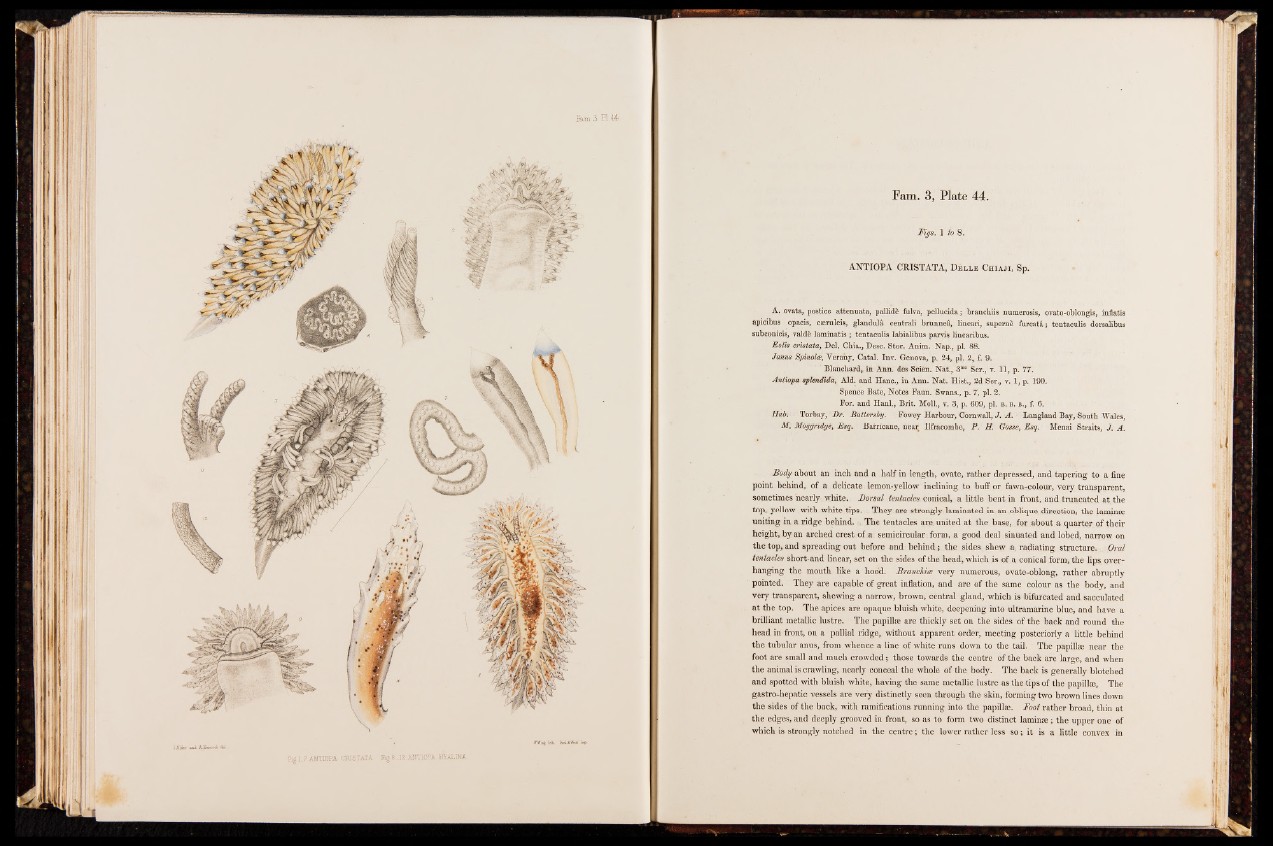
Eg. 1-7. ANTIOPA CRISTATA Fig.8..12.ANTIOPA HYALINA.
Fam. 3, Plate 44.
Figs. 1 to 8.
ANTIOPA CRISTATA, Delle Chiaji, Sp.
A. ovata, postice attenuata, pallide fulva, pellucida; branchiis numerosis, ovato-oblongis, inflatis
apicibus opacis, cseruleis, glandulä centrali brunneä, lineari, superae furcate,; tentaculis dorsalibus
subconicis, valde laminatis ; tentaculis labialibus parvis linearibus.
Eolis cristata, Del. Chia., Desc. Stör. Anim. Nap., pi. 88.
Janus Spinolte, Verahy, Catal. Inv. Genova, p. 24, pi. 2, f. 9.
Blanchard, in Ann. des Seien. Nat., 3me Ser., v. 11, p. 77.
Antiopa splendida, Aid. and Hanc., in Ann. Nat. Hist., 2d Ser., v. 1, p. 190.
Spence Bate, Notes Faun. Swans., p. 7, pi. 2.
For. and Hanl., Brit. Moll., v. 3, p. 609, pi. b. b. b., f. 6.
Hab. Torbay, Dr. Battersby. Fowey Harbour, Cornwall, J. A. Langland Bay, South Wales,
M. Moggridge, Esq. Barricane, hear Ilfracombe, P. H. Gosse, Esq. Menai Straits, J. A.
Body about an inch and a half in length, ovate, rather depressed, and tapering to a fine
point behind, of a delicate lemon-yellow inclining to buff or fawn-colour, very transparent,
sometimes nearly white. Dorsal tentacles conical, a little bent in front, and truncated at the
top, yellow with white tips. They are strongly laminated in an oblique, direction* the laminae
uniting in a ridge behind. , The tentacles are. united at the base, for about a quarter of their
height, by ail arched crest of a semicircular , form, a good deal sinuated and lobed, narrow on
the top, and spreading out before and behind; the sides shew a. radiating structure, Oral
tentacles short-and linear, set on the sides of the head, which is of a conical form, the lips overhanging
the mouth like a hood. Branchice very numerous, ovate-oblong, rather abruptly
pointed. They are capable of great inflation, and are of the same colour as the body, and
very transparent, shewing a narrow, brown, central gland, which is bifurcated and sacculated
at the top. The apices are opaque bluish white, deepening into ultramarine blue, and have a
brilliant metallic lustre. The papillae are thickly set on the sides of the back and round the
head in front, on a pallial ridge, without apparent order, meeting posteriorly a little behind
the tubular anus, from whence a line of white runs down to the tail. The papillae near the
foot are small and much crowded; those towards the centre of the back are large, and when
the animal is crawling, nearly conceal the whole of the body. The back is generally blotched
and spotted with bluish white, having the same metallic lustre as the tips of the papillae. The
gastro-hepatic vessels are very distinctly seen through the skin, forming two brown lines down
the sides of the back, with ramifications running into the papillae. Foot rather broad, thin at
the edges, and deeply grooved in front, so as to form two distinct laminae; the upper one of
which is strongly notched in the centre; the lower rather less so ; it is a little convex in